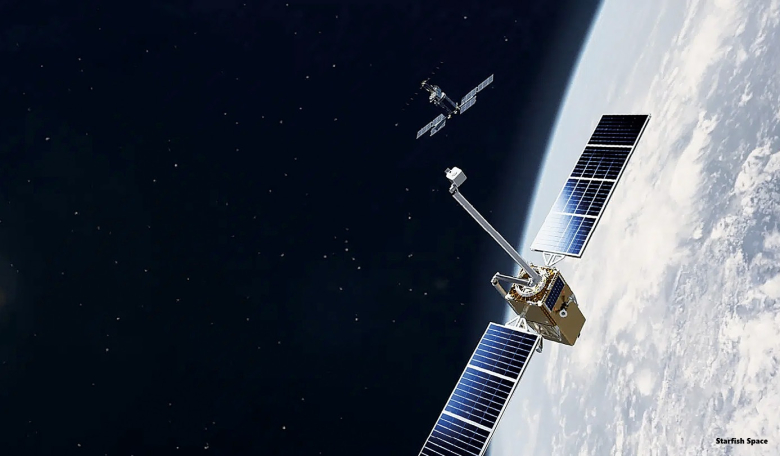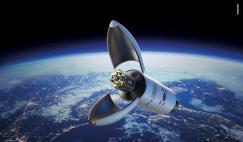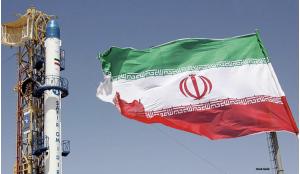What do you do in the event that your property is hit by space debris? This hypothetical question became a reality for Alejandro Otero of Naples, Florida, when a 0.7 kg piece of debris from a 2600 kg cargo pallet packed with batteries jettisoned from the International Space Station crashed through the roof of his house. This discussion unpicks the legal aspects of this unprecedented incident, discussing the existing legal framework, identifying the areas where the law is silent and suggesting what can be done in the future to make both the law and the process more predictable for this type of incident.
The debris in question, measuring 10 cm long by 4 cm wide and weighing 0.7 kg, was identified as part of a stanchion used to mount batteries to an exposed cargo pallet. The pallet was part of a 2600 kg payload released from the International Space Station (ISS) on 11 March 2021, following the delivery and replacement of new batteries, with the expectation that the payload would burn up in the atmosphere within the next 25 years.
However, not all of the cargo burned up, and Mr Otero (the claimant) is seeking damages from NASA for: non-insured property damage loss, business interruption, emotional/mental anguish and the cost of assistance from third parties totalling the sum of US$80,000. While the claimant’s home insurance does cover damages to his home, his attorney stated that a claim will still be made to the Florida court to engage in conversations about what “responsible space operations look like in the international picture”.
Establishing liability
The fundamental question asked by the claimant’s legal team is whether NASA should be held liable for the damage
The fundamental question asked by the claimant’s legal team is whether NASA should be held liable for the damage. The batteries were ejected from the ISS as part of a NASA-led project to upgrade the station. The pallet was supposed to be returned onboard JAXA’s (Japanese Aerospace Exploration Authority) H-IIB launch vehicle, but due to delays it was unable to return on the last flight; thus, it was decided it should be jettisoned from the ISS with the remaining junk.
However, planning an orbital descent for decaying objects is notoriously difficult for anything not spherical, resulting in NASA getting the calculation slightly wrong even though the debris fell just within expected parameters. The question can be legitimately asked about the responsibility of NASA and its legal liability.
International law
Damage done by space objects is dealt with under international law. The Liability Convention (LC) builds on Article VII of the Outer Space Treaty and assigns liability to a “launching state” for damage done by its “space objects”. Such liability is only owed to other States, and not individuals. Despite this, a launching State is “absolutely liable” to pay compensation for damage caused on Earth by its space object (Art II LC).
A couple of points should be noted here. A launching State is a State that either launches or procures the launch of a space object, including States whose territories or facilities were used (Art I(C) (i) and (ii) LC). In addition, absolute liability is the strictest form of legal liability. It does not require the launching State to be at fault in any way. All that is needed is proof that the space object is from the launching State and that it has caused damage.
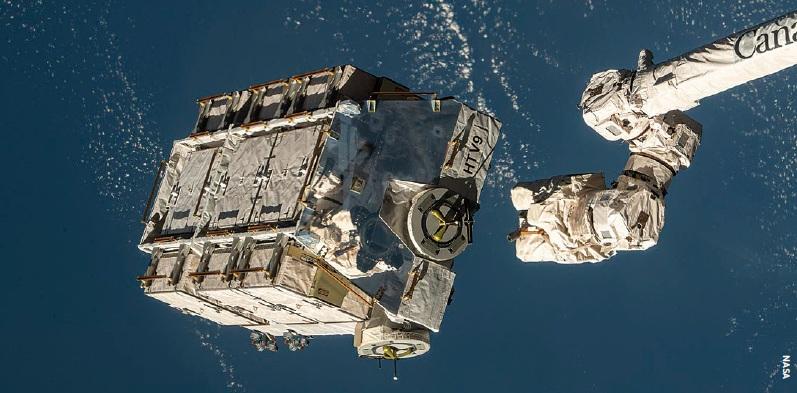 An external pallet packed with old nickel-hydrogen batteries is released by the ISS Canadarm2 robotic arm in March 2021. The pallet was expected to burn up harmlessly in the atmosphere after orbiting Earth for between two to four years but a 0.7 kg piece of it crashed through Alejandro Otero’s roof.
An external pallet packed with old nickel-hydrogen batteries is released by the ISS Canadarm2 robotic arm in March 2021. The pallet was expected to burn up harmlessly in the atmosphere after orbiting Earth for between two to four years but a 0.7 kg piece of it crashed through Alejandro Otero’s roof.
The Liability Convention states that a space object includes component parts and does not have to be the entirety of an object (Art I LC). As the individual components that made up the 2600 kg of rubbish are space objects, it does not matter that just one component damaged the property because the component that caused the damage can be identified.
In this case, Japan and the US were involved in the ISS upgrade operation, so the question remains as to which State is liable. The Liability Convention further states where two or more States jointly launch a space object, they are jointly and severally liable for damage (Art V LC). Where there is difficulty identifying the launching State, especially where more than one State is involved, the answer is to look at the Register of Space Objects.
By channelling liability through States, individual redress for damage caused, under the current regime, is expensive, time consuming and uncertain
According to the Registration Convention (RC), all States that seek to launch space objects must inform the Secretary-General of the United Nations and input the entry into the appropriate register (Art V RC). Where there are two or more launching States, only one of them is to be listed (Art II RC). Being a registered State will almost always be done by a State that is a launching State and therefore, they would be liable for damages. Registration also ensures that States maintain jurisdiction and control over that space object (Art VIII Outer Space Treaty).
In this case, the exposed pallet housing the batteries was registered to Japan, with JAXA listed as the operator. Even though JAXA is listed as the operator, JAXA is not liable because the Outer Space Treaty confirms that States are responsible for governmental agencies and agencies acting in space need supervision and authorisation (Art VI Outer Space Treaty). As it stands, Japan would be held liable for damage done by space debris registered to them, which in this case is the pallet of batteries that crashed through the claimant’s house.
Seeking compensation
Japan may be liable for this damage but seeking compensation is made difficult due to several factors. First, this is an international matter with multiple organisations involved. Second, there is no precedent on how an individual case like this should be handled. And finally, damage done by space debris is a State-to-State issue, as the international treaties hold States responsible for any damage done by space objects.
No mechanisms exist outside the conventions to deal with individual claims. It was suggested by Michelle Hanlon, Executive Director of the Center for Air and Space Law at the University of Mississippi, that the claimant could make a claim under the Federal Torts Claims Act which would allow him to sue the US government for negligence in relation to space debris but the claimant’s argued the laws were too “inadequate” for this area.
Under the Liability Convention, where a launching State has paid compensation for damage, that State has a right to present a claim for indemnification to the other participants in the joint launch (Art V LC). It might be that the US government could make an indemnification claim against Japan through diplomatic channels, or negotiate a deal and pay that to the claimant, if the US government chooses to make the claim at all. Japan might try to argue that NASA was grossly negligent in its predictions of space debris decay which, if successful, would fully absolve Japan of absolute liability, so the US government would have to indemnify the claimant instead (Art VI LC).
The State that is nominally liable would normally seek redress from an operator’s insurance, so in this case Japan could seek out JAXA or whatever insurance they claimed. Third-party liability insurance covers claims of damage done to terrestrial property and bodily injury caused by space debris. However, few nations have implemented insurance due to a lack of domestic laws by State Parties to the Treaty. Whilst some satellites are insured, very few are covered for third party liability.
Domestic legislation could be used to ensure that operators have third party liability insurance covering damage on Earth from their space objects
Regarding Japan’s domestic law on space insurance, the Space Activity Act requires third-party insurance, and an appropriate government indemnity that sufficiently covers liability is required for the purpose of launch.
Interestingly though, there is no mandatory third-party liability insurance for ‘in-orbit’ activities, so whether the pallet of batteries registered to Japan was insured under third party insurance is by no means clear.
Regardless of the insurance position, this claim demonstrates a gap in the liability regime. By channelling liability through States, individual redress for damage caused, under the current regime, is expensive, time consuming and uncertain.
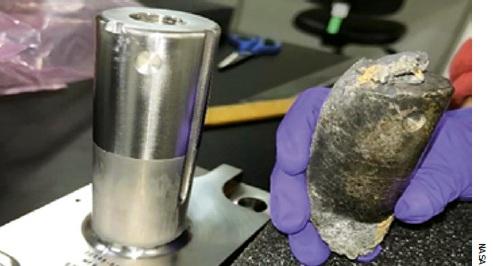 Close-up of the debris compared to a pristine version - a small section of a stanchion used to mount batteries to the exposed cargo pallet.
Close-up of the debris compared to a pristine version - a small section of a stanchion used to mount batteries to the exposed cargo pallet.
Future guidelines
As space becomes busier, these kinds of incidents become more likely. Work must continue to safeguard space activity and mitigate risks of collisions from orbital debris. The importance of this work is highlighted through the Long-Term Sustainability (LTS) Guidelines and the Space Debris Mitigation Guidelines.
These Guidelines call for improved accuracy of orbital data and space objects and the sharing of orbital information and space object monitoring information. Part B of the Guidelines provides a potential outline of a more robust provision of data about space.
The increasing number of satellites in orbit lends an urgency to the need for improving Space Situational Awareness (SSA). Only through this can satellite collision avoidance manoeuvres, communication between operators and trackers, and data sharing be fully realised.
NASA has established a space sustainability division that consolidates a lot of the work surrounding the challenges of orbital debris research which encompasses the Space Operations Mission Directorate, including debris issues from the ISS. Further, Starfish Space have landed substantial contracts from NASA, the US Space Force and Intelsat to develop and launch their ‘Otter’ spacecraft that has augmented manoeuvring techniques which will lead to better end-of-life disposal.
The Long-Term Sustainability Guidelines promulgated by the UN provide a starting point for shaping State regulation towards a more sustainable approach. They are not intended, however, to make any impact on the liability lacuna which the Otero case has brought to light. Domestic legislation could be used to ensure that operators have third party liability insurance covering damage on Earth from their space objects. States could also instigate discussions at the UN Committee on the Peaceful Uses of Outer Space (COPUOS) to try to develop a shared understanding of how liability can protect not only state interests but also individuals as space activities increase.
Market share liability could prove an incentive for States to focus on reducing their production of large debris
Another suggestion is to establish a market-share liability scheme which would assign liability based on the proportion of debris-generating activities each actor contributes to the overall space environment. Those who create space debris would contribute an amount of money to a fund as a percentage of how much they are responsible for the space debris problem. For example, if a State has contributed to 75 percent of the space debris in orbit, it would cover 75 percent of the required compensation to a claimant that comes out of the accumulated fund. This would only apply to damage done in orbit, as absolute liability would still apply to damage caused on or to Earth by a specific launching State. That said, this scheme is particularly useful as a compensation model for in-orbit incidents as it is particularly difficult to identify fault in outer space, thus freeing the Claimant from needing to prove causation by a specific State.
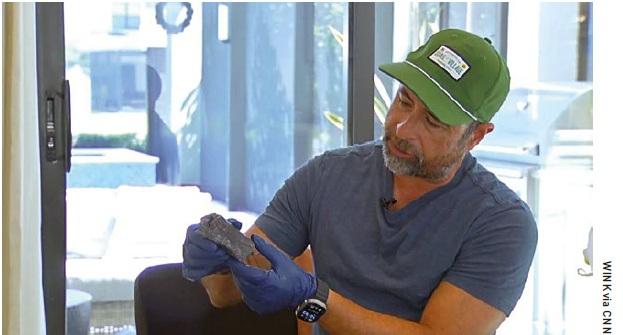 Alejandro Otero holds the piece of debris that hit his house in March 2024, released from an external pallet on the ISS in 2021.
Alejandro Otero holds the piece of debris that hit his house in March 2024, released from an external pallet on the ISS in 2021.
Another possible benefit is that market share liability could prove an incentive for States to focus on reducing their production of large debris. A downside, however, is because the model works on mutual cooperation, you cannot force States to contribute to the fund. Those who are contributing the most to the space debris issue are unlikely to want to contribute so much money. Further, this scheme would only apply to States, so if a company or individual wanted to make a claim, they would not be entitled to the market-share fund, and would have to go through diplomatic channels.
The question of what happens if space debris lands on your property is one that is now the subject of domestic litigation in the US. Under international law, the launching State is liable for damage caused by its space objects. What is lacking from this is a clear and accessible route for an individual to seek compensation. Future work must continue to focus on dealing with the threat posed by space debris for the sustainability of the outer space environment. That does not discharge space faring nations from a duty to ensure that those who suffer damage are adequately compensated.
About the authors
J. Lauren Napier BS, MA, PhD is an Assistant Professor in the Northumbria Law School at Northumbria University. She completed her PhD on the intersection of international law and international relations in respect of the governance of low Earth Orbit. She has recently been part of the UK delegation to the UN Committee on the Peaceful Uses of Outer Space, speaking as part of the Women In Space (WISPER) project.
Molly Doyle is a PhD candidate at Northumbria University studying the Global Governance of Space Traffic Coordination. Previously, she had studied at Northumbria University for her Master of Law receiving a First Class Honours in 2023. During this time, she enlisted as an RAF reservist with the Northumbrian Universities Air Squadron and was with the squadron for three years.





